City Intelligence Quotient Evaluation System Using Crowdsourced Social Media Data: A Case Study of the Yangtze River Delta Region, China
Abstract
:1. Introduction
2. Literature Review
2.1. Concept of “Smart Cities”
2.2. Prevalent Evaluation Systems of Smart Cities
2.3. Evaluations Using Crowdsourced Public Opinion Data
3. Research Methodology
- (1)
- Intelligent Construction and Environment;
- (2)
- Intelligent Governance and Service;
- (3)
- Intelligent Economy and Industry;
- (4)
- Intelligent Hardware Construction;
- (5)
- Residents’ Intelligent Capacity.
3.1. Using Public Opinion to Replace Statistical Data
- Collection of a raw labeled dataset for sentiment analysis. The raw social media datasets with the keywords were collected. The plain texts were collected from Weibo posts (in Chinese) before data cleaning.
- Preprocessing of the texts. After data cleaning, text preprocessing was carried out, transforming Chinese texts with sentiment into mathematical matrixes. Word to vector technology predicted the word vectors of feature words according to their contexts. The strong correlation between synonyms was maintained, and the contexts could be speculated according to the feature words.
- Numerical encoding of texts. The text sentiment analysis technology based on active learning was adopted to analyze social media posts [47], to determine whether a given text in the data was positive, negative or neutral by extracting the meaning from the natural language and assigning it a numerical score from 0 to 100. This study chose a custom-trained supervised machine learning model and the active learning model for sentiment analysis. Text sentiment analysis and self-learning classification based on a small number of text labels were used.
- Choosing the appropriate machine learning algorithm. After obtaining the text vector, the next step was to train the classifier. The active learning method was employed, which can obtain more valuable label samples with less labor cost and better generalization performance. In the active learning model, we used a random forest classifier as the classification model.
- Hypertuning and training machine learning model.
- Prediction. The efficiency of the active learning algorithm lied in the use of specific strategies to minimize the number of samples that needed to be labeled in the supervised process and to reduce labor cost from labeling useless samples. Active learning was essentially part of a supervised process, and it could compress training samples to a tenth or less of their original size to achieve similar training effects. This was essential to train a robust machine learning model. The machine learning model would learn various patterns in the dataset and could predict sentiment for a given unseen text. We collected the raw labeled dataset for sentiment analysis before building the active learning model. The training was carried out based on a raw labeled dataset consisting of about 20,000 social media posts in Chinese. A total of 2000 texts were used for initialization, and training iterations were 50–100 times. Finally, the accuracy of the training results was 75–80%.
3.2. Analytical Framework
- (1)
- Data acquisition. The twenty indicators that represent the development of urban intelligence are semantically transformed to form a keyword list for online search purposes. According to the keyword search list formed through intelligent semantic transformation, data from the mainstream social media site Weibo (the equivalent to Twitter in China) were obtained in this research. Weibo means ‘microblog’, and it provides the most important microblogging service in China [51,52]. The Weibo data were collected from Sina Weibo by using Sina Weibo’s application programming interface (http://open.weibo.com/ (accessed on 1 August 2021)). The Weibo user-generated content was cleaned and filtered by the keywords by natural language processing [53]. This method introduced artificial intelligence technologies, such as machine training and semantic association to expand the scope of the meaning of keywords (shown in the Appendix A) and, thus, to obtain more abundant information.
- (2)
- Data analysis and processing. The semantic analysis and text sentiment analysis models are introduced to infer citizens’ evaluation of city smartness from different perspectives. The Weibo data scraped by the keywords are converted into the corresponding score index through semantic analysis. Semantic transformation technology is one of the innovations of this index system, which is based on a semantic analysis and text sentiment analysis model. The textual content in social media reflects citizens’ sentiments. Text sentiment analysis categorizes texts on a given topic based on the sentimental opinions conveyed, which can be negative, neutral or positive. Based on the text semantic analysis and sentiment analysis results of the keywords [54], the CityIQ scores of twenty indicators are derived. The score of each indicator ranges from 0 to 100.
- (3)
- CityIQ analysis. With the CityIQ scores of twenty indicators, the scores of five dimensions are calculated. The score of each dimension is the average value of the four indicator scores of this dimension, and ranges from 0 to 100. The CityIQ scores of different cities are compared from multi-dimensional perspectives. The time-series changes of the scores are obtained every week in the CityIQ evaluation system, thus providing a dynamic ranking of each city. Social media geo-tag posts with coordinates generated by social media users and the specific location data collected from city level administrative areas are defined as data of selected cities.
3.3. Study Area and Data Processing
3.3.1. Study Area
3.3.2. Data Processing
4. Case Study
4.1. CityIQ Analysis of the Yangtze River Delta Cities
4.2. Collaborations among the Yangtze River Delta Cities in Terms of Intelligent Development
5. Conclusions
Author Contributions
Funding
Conflicts of Interest
Appendix A
| Primary Dimension | Indicator | Keywords |
|---|---|---|
| Intelligent Construction and Environment | Environment monitoring | Air quality, air pollution index, AQI, fog and haze, PM 2.5 real-time monitoring, atmospheric pollution, air monitoring, air purifier, suspended particles |
| Pollution monitoring | Atmospheric pollution, air pollution, PM 2.5, water pollution, solid waste pollution, soil pollution, chemical pollution, coal-fired, nitrogen oxides, carbon monoxide, noise pollution | |
| Intelligent construction | Internet of things, 5G, smart transportation, unmanned driving, artificial intelligence, cloud computing, big data, scientific and technological innovation, VR, virtual reality, BIM, CIM, smart life, intelligent manufacturing | |
| Green energy | Low carbon, clean energy, renewable energy, green industry, solar energy, new energy, wind energy, nuclear energy, biological energy | |
| Intelligent Governance and Service | E-government | Informatization, automatic office, intelligent management, smart government, e-commerce |
| Emergency alert | Disaster prevention and reduction, meteorological disaster, geological disaster, natural disaster warning, warning system, sensor, emergency response | |
| Smart transportation | Traffic, transportation, highway traffic, unmanned driving, intelligent transportation, transport facilities, urban transport, public transit, rail transport | |
| Smart health care | Health, physical health, mental health, smart hospital, smart medical, artificial intelligence doctor, electronic medical record, mobile phone registration | |
| Intelligent Economy and Industry | Smart agriculture | Agricultural big data, modern agriculture, Internet of Things, mechanization, automatic control system |
| Smart industries | Internet of Things, intelligent production, 3D Printing, connected factory, smart factory, intelligent manufacturing, Industry 4.0, industrial internet, smart commercial district | |
| Innovative idea | Business wisdom, cultural creativity, creative industry center, characteristic town, business incubator, creative industry | |
| Entrepreneurial support | Policy support, fiscal policy, policy support, talent introduction, settlement policy | |
| Intelligent Hardware Construction | Wireless network | Wireless coverage, 5G, broadband, network performance, Wi-Fi, wireless communication |
| Broadband speed | Broadband, optical fiber, broadband speed, network speed | |
| Data center | Data information, data transmission, data processing, data center facilities, big data center, urban brain | |
| Smart grid | Smart pipeline, oil and gas pipeline facilities, transportation, water supply network, pipeline maintenance | |
| Residents’ Intelligent Capacity | Public participation | Public, indirect participation, direct participation, public management, consulting and complaints, public sentiment, public opinion |
| Digital library | Resources website, learning resources sharing, digital books, digital library, smart education, smart campus, educational informationization | |
| Tertiary education | Education, higher education, basic education, universal education, cultural education, elementary education, adult education, continuing education, diploma, training | |
| Talent policy | Talent policy, innovative talent, talent apartment, professional talent, settlement policy, talent introduction |
References
- Batty, M.; Axhausen, K.W.; Giannotti, F.; Pozdnoukhov, A.; Bazzani, A.; Wachowicz, M.; Ouzounis, G.; Portugali, Y. Smart cities of the future. Eur. Phys. J. Spéc. Top. 2012, 214, 481–518. [Google Scholar] [CrossRef] [Green Version]
- Silva, B.N.; Khan, M.; Han, K. Towards sustainable smart cities: A review of trends, architectures, components, and open challenges in smart cities. Sustain. Cities Soc. 2018, 38, 697–713. [Google Scholar] [CrossRef]
- Meijer, A.; Bolívar, M.P.R. Governing the smart city: A review of the literature on smart urban governance. Int. Rev. Adm. Sci. 2015, 82, 392–408. [Google Scholar] [CrossRef]
- Caird, S. City approaches to smart city evaluation and reporting: Case studies in the United Kingdom. Urban Res. Pract. 2018, 11, 159–179. [Google Scholar] [CrossRef]
- Angelidou, M. Smart cities: A conjuncture of four forces. Cities 2015, 47, 95–106. [Google Scholar] [CrossRef]
- Debnath, A.K.; Chin, H.C.; Haque, M.; Yuen, B. A methodological framework for benchmarking smart transport cities. Cities 2014, 37, 47–56. [Google Scholar] [CrossRef] [Green Version]
- Cocchia, A. Smart and Digital City: A Systematic Literature Review. In Smart City; Springer International Publishing: Cham, Switzerland, 2014; pp. 13–43. [Google Scholar] [CrossRef]
- Meijer, A.J.; Gil-Garcia, J.R.; Bolívar, M.P.R. Smart city research: Contextual conditions, governance models, and public value assessment. Soc. Sci. Comput. Rev. 2016, 34, 647–656. [Google Scholar] [CrossRef]
- Gabrys, J. Programming Environments: Environmentality and Citizen Sensing in the Smart City. Environ. Plan. D Soc. Space 2014, 32, 30–48. [Google Scholar] [CrossRef] [Green Version]
- Albino, V.; Berardi, U.; Dangelico, R.M. Smart Cities: Definitions, Dimensions, Performance, and Initiatives. J. Urban Technol. 2015, 22, 3–21. [Google Scholar] [CrossRef]
- Batty, M. Smart Cities, Big Data. Environ. Plan. B Plan. Des. 2012, 39, 191–193. [Google Scholar] [CrossRef] [Green Version]
- Myeong, S.; Jung, Y.; Lee, E. A Study on Determinant Factors in Smart City Development: An Analytic Hierarchy Process Analysis. Sustainability 2018, 10, 2606. [Google Scholar] [CrossRef] [Green Version]
- Hollands, R.G. Will the real smart city please stand up? City 2008, 12, 303–320. [Google Scholar] [CrossRef]
- Vanolo, A. Smartmentality: The Smart City as Disciplinary Strategy. Urban Stud. 2013, 51, 883–898. [Google Scholar] [CrossRef]
- Giffinger, R.; Gudrun, H. Smart cities ranking: An effective instrument for the positioning of the cities? ACE Arch. City Environ. 2010, 4, 7–26. [Google Scholar] [CrossRef] [Green Version]
- Allwinkle, S.; Cruickshank, P. Creating Smarter Cities: An Overview. J. Urban Technol. 2011, 18, 1–16. [Google Scholar] [CrossRef]
- De Jong, M.; Joss, S.; Schraven, D.; Zhan, C.; Weijnen, M. Sustainable–smart–resilient–low carbon–eco–knowledge cities; making sense of a multitude of concepts promoting sustainable urbanization. J. Clean. Prod. 2015, 109, 25–38. [Google Scholar] [CrossRef] [Green Version]
- Ahvenniemi, H.; Huovila, A.; Pinto-Seppä, I.; Airaksinen, M. What are the differences between sustainable and smart cities? Cities 2017, 60, 234–245. [Google Scholar] [CrossRef]
- Kramers, A.; Höjer, M.; Lövehagen, N.; Wangel, J. Smart sustainable cities—Exploring ICT solutions for reduced energy use in cities. Environ. Model. Softw. 2014, 56, 52–62. [Google Scholar] [CrossRef]
- Dameri, R.P. Searching for Smart City definition: A comprehensive proposal. Int. J. Comput. Technol. 2013, 11, 2544–2551. [Google Scholar] [CrossRef]
- Batty, M. Big data, smart cities and city planning. Dialog-Hum. Geogr. 2013, 3, 274–279. [Google Scholar] [CrossRef]
- Lee, J.H.; Hancock, M.G.; Hu, M.-C. Towards an effective framework for building smart cities: Lessons from Seoul and San Francisco. Technol. Forecast. Soc. Chang. 2014, 89, 80–99. [Google Scholar] [CrossRef]
- Mahizhnan, A. Smart cities: The Singapore case. Cities 1999, 16, 13–18. [Google Scholar] [CrossRef]
- Shapiro, J.M. Smart Cities: Quality of Life, Productivity, and the Growth Effects of Human Capital. Rev. Econ. Stat. 2006, 88, 324–335. [Google Scholar] [CrossRef]
- Giffinger, R.; Fertner, C.; Kramar, H.; Kalasek, R.; Milanović, N.; Meijers, E. Smart Cities—Ranking of European Medium-Sized Cities; Centre of Regional Science, Vienna University of Technology: Vienna, Austria, 2007. [Google Scholar]
- Schuurman, D.; Baccarne, B.; De Marez, L. Smart Ideas for Smart Cities: Investigating Crowdsourcing for Generating and Selecting Ideas for ICT Innovation in a City Context. J. Theor. Appl. Electron. Commer. Res. 2012, 7, 11–12. [Google Scholar] [CrossRef] [Green Version]
- Shelton, T.; Lodato, T. Actually existing smart citizens. City 2019, 23, 35–52. [Google Scholar] [CrossRef]
- Abu-Rayash, A.; Dincer, I. Development of integrated sustainability performance indicators for better management of smart cities. Sustain. Cities Soc. 2021, 67, 102704. [Google Scholar] [CrossRef]
- Pira, M. A novel taxonomy of smart sustainable city indicators. Humanit. Soc. Sci. Commun. 2021, 8, 197. [Google Scholar] [CrossRef]
- Neirotti, P.; De Marco, A.; Cagliano, A.C.; Mangano, G.; Scorrano, F. Current trends in Smart City initiatives: Some stylised facts. Cities 2014, 38, 25–36. [Google Scholar] [CrossRef] [Green Version]
- Kummitha, R.K.R.; Crutzen, N. How do we understand smart cities? An evolutionary perspective. Cities 2017, 67, 43–52. [Google Scholar] [CrossRef]
- Angelidou, M. Smart city policies: A spatial approach. Cities 2014, 41, S3–S11. [Google Scholar] [CrossRef]
- Huovila, A.; Bosch, P.; Airaksinen, M. Comparative analysis of standardized indicators for Smart sustainable cities: What indicators and standards to use and when? Cities 2019, 89, 141–153. [Google Scholar] [CrossRef]
- Nieminen, M.; Hyytinen, K. Future-oriented impact assessment: Supporting strategic decision-making in complex socio-technical environments. Evaluation 2015, 21, 448–461. [Google Scholar] [CrossRef] [Green Version]
- Joss, S.; Sengers, F.; Schraven, D.; Caprotti, F.; Dayot, Y. The Smart City as Global Discourse: Storylines and Critical Junctures across 27 Cities. J. Urban Technol. 2019, 26, 3–34. [Google Scholar] [CrossRef] [Green Version]
- Rahman, M.; Ali, G.N.; Li, X.J.; Samuel, J.; Paul, K.C.; Chong, P.H.; Yakubov, M. Socioeconomic factors analysis for COVID-19 US reopening sentiment with Twitter and census data. Heliyon 2021, 7, e06200. [Google Scholar] [CrossRef] [PubMed]
- See, L.; Mooney, P.; Foody, G.M.; Bastin, L.; Comber, A.; Estima, J.; Fritz, S.; Kerle, N.; Jiang, B.; Laakso, M.; et al. Crowdsourcing, Citizen Science or Volunteered Geographic Information? The Current State of Crowdsourced Geographic Information. ISPRS Int. J. Geo-Inf. 2016, 5, 55. [Google Scholar] [CrossRef]
- Wu, Z.; Pan, Y.; Ye, Q.; Kong, L. The City Intelligence Quotient (City IQ) Evaluation System: Conception and Evaluation. Engineering 2016, 2, 196–211. [Google Scholar] [CrossRef] [Green Version]
- Intelligent Community Indicators. Available online: https://www.intelligentcommunity.org/method (accessed on 9 June 2021).
- Kourtit, K.; Nijkamp, P.; Arribas, D. Smart cities in perspective—A comparative European study by means of self-organizing maps. Innov. Eur. J. Soc. Sci. Res. 2012, 25, 229–246. [Google Scholar] [CrossRef]
- IDC Launches Smart City Evolution Index. Opens Public Voting to Identify Top Smart City Projects in Asia/Pacific. Available online: https://www.idc.com/ap/pulse/2016-february (accessed on 20 April 2021).
- Dirks, S.; Keeling, M.; Dencik, J. How Smart Is Your City?: Helping Cities Measure Progress; IBM Institute for Business Value, IBM Global Business Services: New York, NY, USA, 2009. [Google Scholar]
- Shanghai: Smart City Evaluation Index System 2.0. Available online: http://www.pudong.gov.cn/shpd/news/20121219/006002_1cfd6faf-d6d7-462e-abc5-533b4edf8cea.htm (accessed on 25 August 2021).
- European Smart Cities 4.0. Available online: http://smart-cities.eu/?cid=2&ver=4 (accessed on 20 September 2021).
- Kitchin, R. The real-time city? Big data and smart urbanism. GeoJournal 2014, 79, 1–14. [Google Scholar] [CrossRef] [Green Version]
- Gong, Z.; Cai, T.; Thill, J.-C.; Hale, S.; Graham, M. Measuring relative opinion from location-based social media: A case study of the 2016 U.S. presidential election. PLoS ONE 2020, 15, e0233660. [Google Scholar] [CrossRef]
- Lyu, K.; Kim, H. Sentiment Analysis Using Word Polarity of Social Media. Wirel. Pers. Commun. 2016, 89, 941–958. [Google Scholar] [CrossRef]
- Kryvasheyeu, Y.; Chen, H.; Moro, E.; Van Hentenryck, P.; Cebrian, M. Performance of Social Network Sensors during Hurricane Sandy. PLoS ONE 2015, 10, e0117288. [Google Scholar] [CrossRef] [Green Version]
- Allen, C.; Tsou, M.-H.; Aslam, A.; Nagel, A.; Gawron, J.-M. Applying GIS and Machine Learning Methods to Twitter Data for Multiscale Surveillance of Influenza. PLoS ONE 2016, 11, e0157734. [Google Scholar] [CrossRef] [PubMed]
- Ye, X.; Wei, X. Multi-Dimensional Analysis of El Niño on Twitter: Spatial, Social, Temporal, and Semantic Perspectives. ISPRS Int. J. Geo-Inf. 2019, 8, 436. [Google Scholar] [CrossRef] [Green Version]
- Liu, J.C.-E.; Zhao, B. Who speaks for climate change in China? Evidence from Weibo. Clim. Chang. 2016, 140, 413–422. [Google Scholar] [CrossRef]
- Liu, X.; Song, Y.; Wu, K.; Wang, J.; Li, D.; Long, Y. Understanding urban China with open data. Cities 2015, 47, 53–61. [Google Scholar] [CrossRef]
- Zhou, X.; Wang, M.; Li, D. From stay to play—A travel planning tool based on crowdsourcing user-generated contents. Appl. Geogr. 2017, 78, 1–11. [Google Scholar] [CrossRef]
- Wang, Z.; Ye, X. Social media analytics for natural disaster management. Int. J. Geogr. Inf. Sci. 2018, 32, 49–72. [Google Scholar] [CrossRef]
- Segev, E. Google and the Digital Divide: The Bias of Online Knowledge; Elsevier Science & Technology: Witney, UK, 2010. [Google Scholar]
- Yang, T.; Ye, M.; Pei, P.; Shi, Y.; Pan, H. City Branding Evaluation as a Tool for Sustainable Urban Growth: A Framework and Lessons from the Yangtze River Delta Region. Sustainability 2019, 11, 4281. [Google Scholar] [CrossRef] [Green Version]
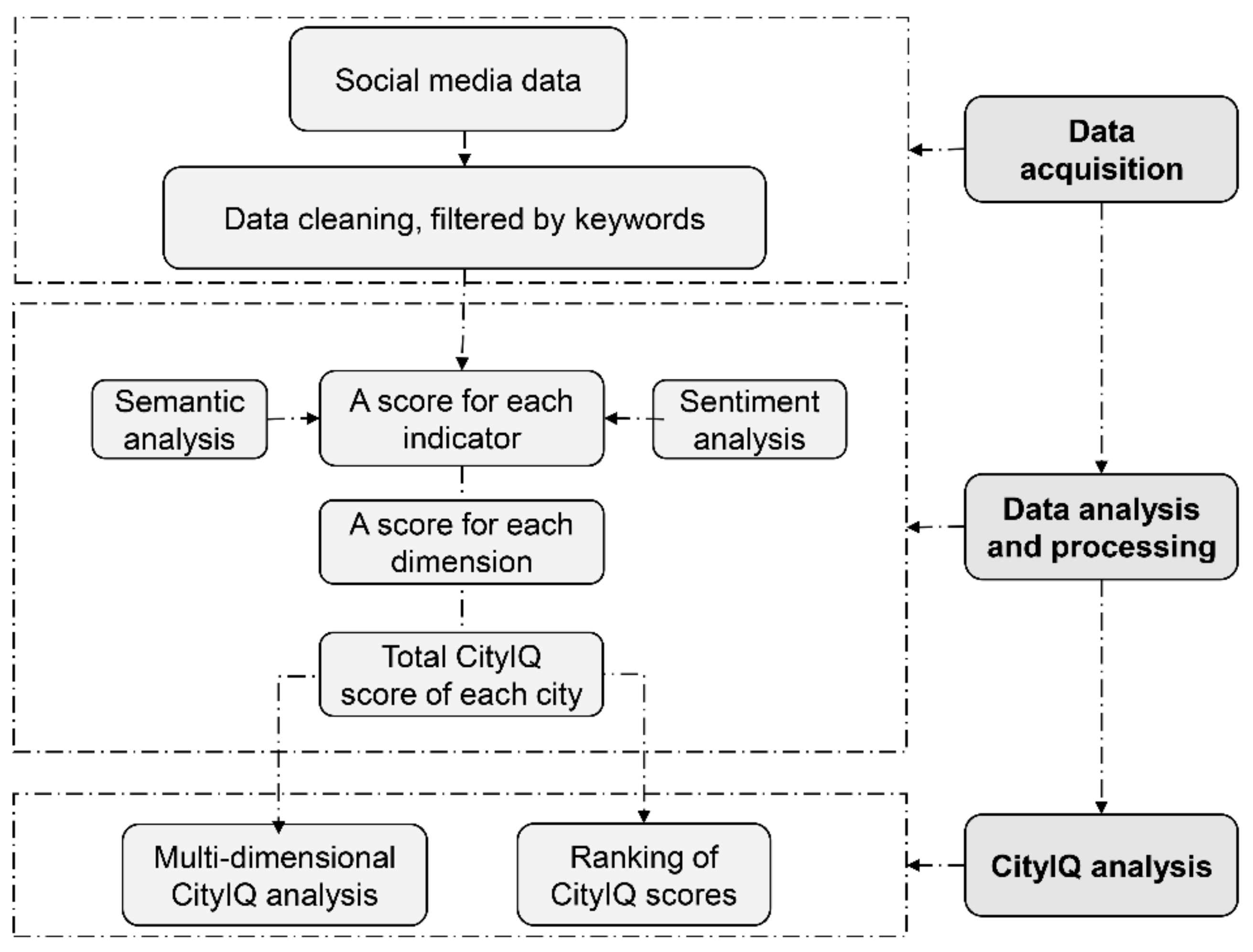
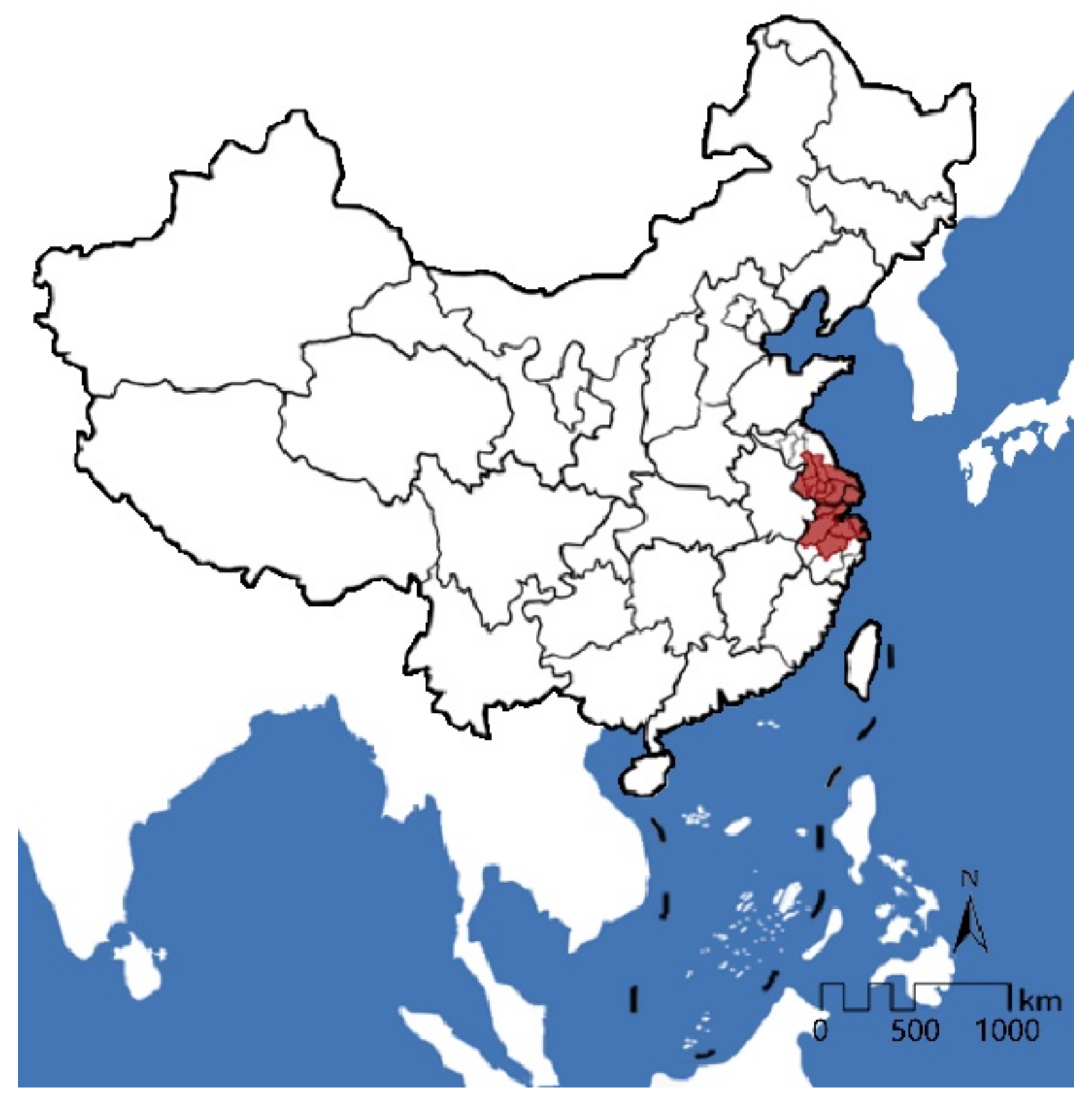

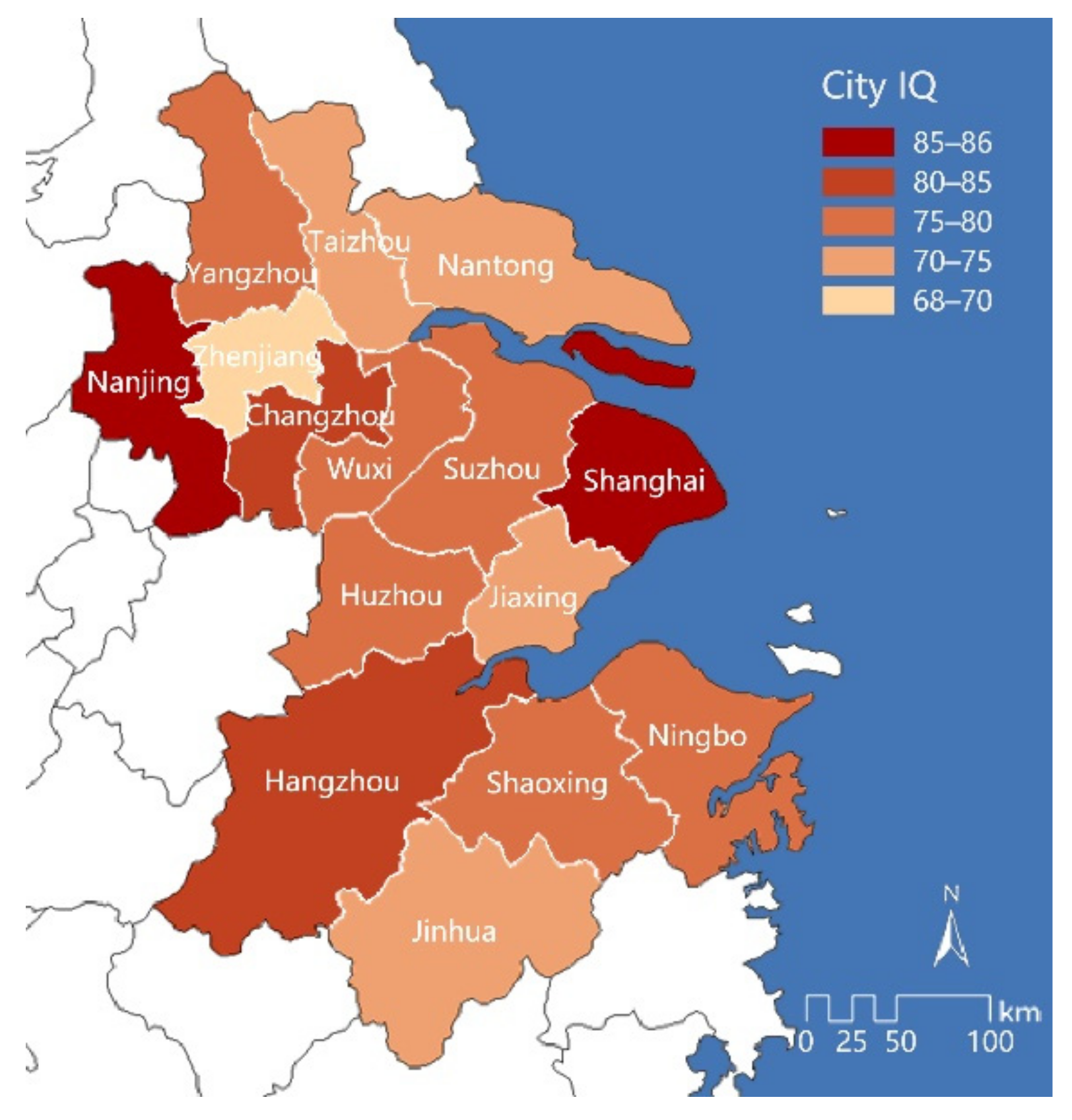

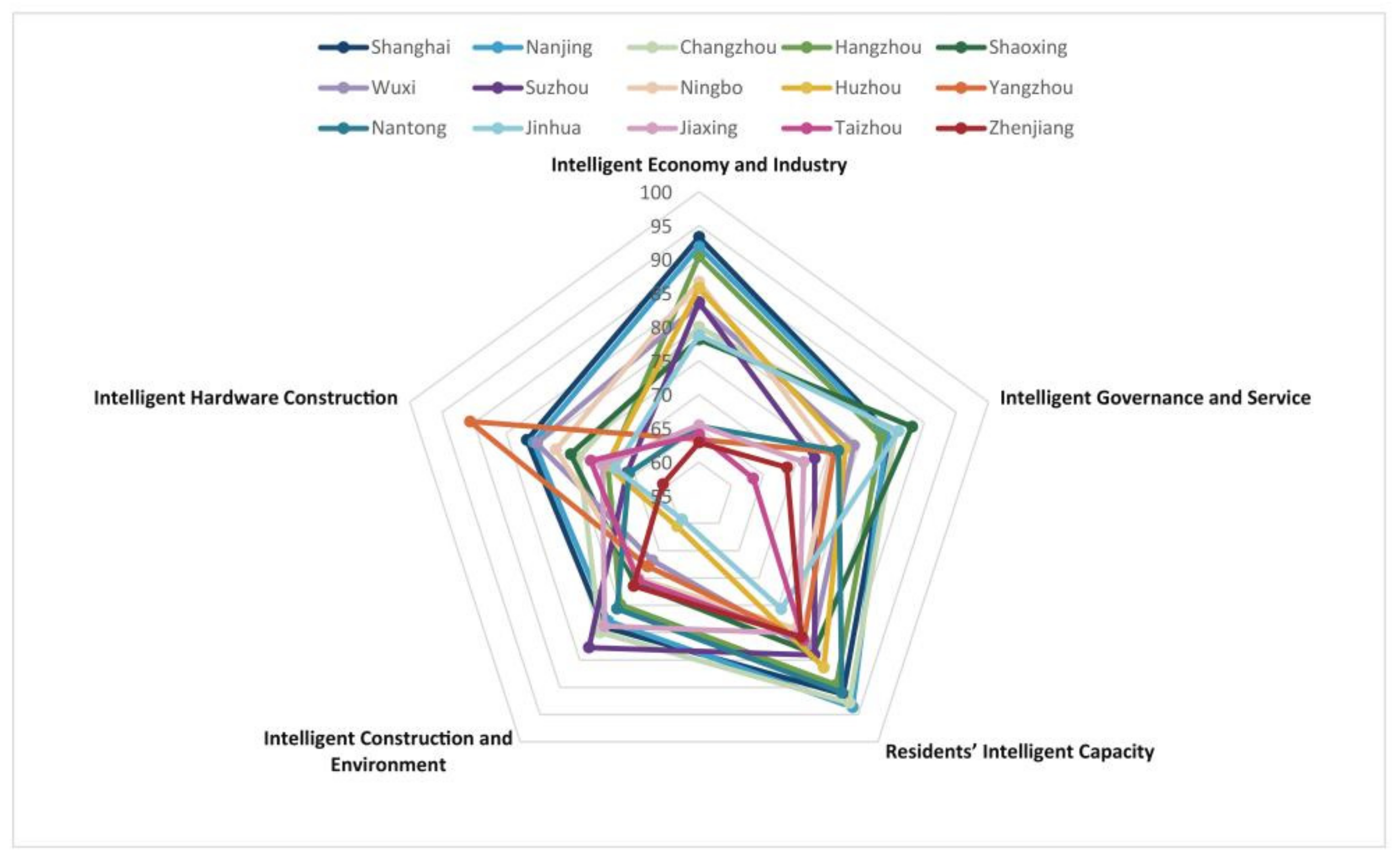
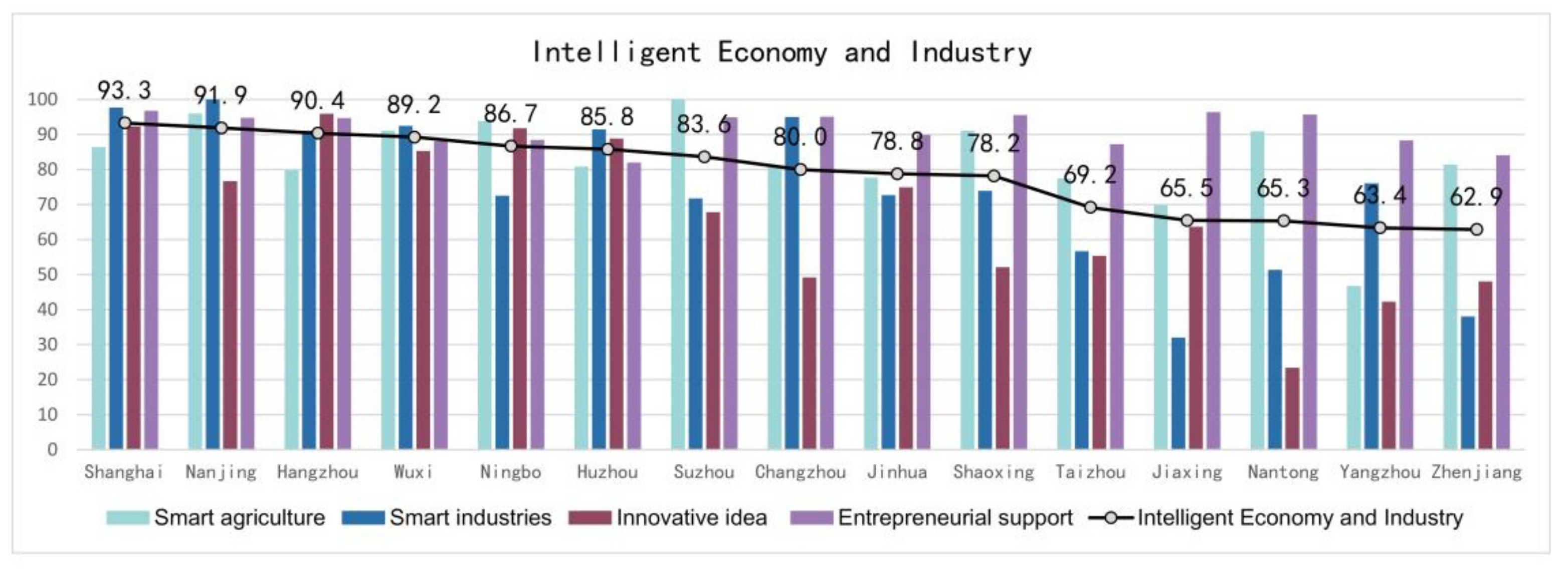



| No. | Intelligent City Evaluation Systems | Year | Research Team | Number of Primary Dimensions | Content of Primary Dimensions | Number of Secondary Indicators |
|---|---|---|---|---|---|---|
| 1 | TU Wien System [25] | 2007 | Rudolf Giffinger | 6 | Intelligent economy, intelligent people, intelligent governance, intelligent mobility, intelligent environment and intelligent living | 31 |
| 2 | Intelligent Community Forum System [39] | 2001 | Intelligent Community Forum Institute | 4 | Broadband, innovation, digital inclusion, marketing and advocacy | 18 |
| 3 | Comparative European Smart City System [40] | 2012 | Karima Kourtit, Peter Nijkamp, Daniel Arribas | 3 | Prosperous commerce and social-cultural attraction, labor and municipal facility capacity and high-end e-service usage | 0 |
| 4 | Int’l Digital Corporation Smart City Index [41] | 2011 | Int’l Digital Corporation | 5 | Government, buildings, transportation, energy, environment and service | 23 |
| 5 | IBM Evaluation Matrix [42] | 2010 | IBM Corporation | 7 | Transportation, communication, water, energy, city service, citizens and commerce | 0 |
| 6 | Shanghai Pudong Smart System [43] | 2012 | Shanghai Pudong Smart City Research Institute | 5 | Infrastructure, public management and service, information service for economic development, humanity and science attainment and citizen awareness | 18 |
| 7 | European Smart Cities 4.0 [44] | 2015 | Rudolf Giffinger, Hans Kramar, Gudrun Haindlmaier, Florian Strohmayer | 6 | Smart Economy, smart mobility, smart environment, smart people, smart living and smart governance | 27 |
| 8 | Integrated Sustainability Smart City System [28] | 2021 | AzzamAbu-Rayash, Ibrahim Dincer | 8 | Economy, environment, society, governance, energy, infrastructure, transportation and pandemic resiliency | 32 |
| 9 | Smart Sustainable City System [29] | 2021 | Milad Pira | 4 | Socio-cultural, economic, environmental and governance | 28 |
| Primary Dimensions | Secondary Indicators |
|---|---|
| (1) Intelligent Construction and Environment | Environmental monitoring |
| Pollution monitoring | |
| Intelligent construction | |
| Green energy | |
| (2) Intelligent Governance and Service | E-government |
| Emergency alerts | |
| Smart transportation | |
| Smart health care | |
| (3) Intelligent Economy and Industry | Smart agriculture |
| Smart industries | |
| Innovative ideas | |
| Entrepreneurial support | |
| (4) Intelligent Hardware Construction | Wireless network |
| Broadband speed | |
| Data centers | |
| Smart grid | |
| (5) Residents’ Intelligent Capacity | Public participation |
| Digital libraries | |
| Tertiary education | |
| Talent policy |
Publisher’s Note: MDPI stays neutral with regard to jurisdictional claims in published maps and institutional affiliations. |
© 2021 by the authors. Licensee MDPI, Basel, Switzerland. This article is an open access article distributed under the terms and conditions of the Creative Commons Attribution (CC BY) license (https://creativecommons.org/licenses/by/4.0/).
Share and Cite
Wu, Z.; Li, X.; Zhou, X.; Yang, T.; Lu, R. City Intelligence Quotient Evaluation System Using Crowdsourced Social Media Data: A Case Study of the Yangtze River Delta Region, China. ISPRS Int. J. Geo-Inf. 2021, 10, 702. https://doi.org/10.3390/ijgi10100702
Wu Z, Li X, Zhou X, Yang T, Lu R. City Intelligence Quotient Evaluation System Using Crowdsourced Social Media Data: A Case Study of the Yangtze River Delta Region, China. ISPRS International Journal of Geo-Information. 2021; 10(10):702. https://doi.org/10.3390/ijgi10100702
Chicago/Turabian StyleWu, Zhiqiang, Xiang Li, Xingang Zhou, Tianren Yang, and Ruiyao Lu. 2021. "City Intelligence Quotient Evaluation System Using Crowdsourced Social Media Data: A Case Study of the Yangtze River Delta Region, China" ISPRS International Journal of Geo-Information 10, no. 10: 702. https://doi.org/10.3390/ijgi10100702
APA StyleWu, Z., Li, X., Zhou, X., Yang, T., & Lu, R. (2021). City Intelligence Quotient Evaluation System Using Crowdsourced Social Media Data: A Case Study of the Yangtze River Delta Region, China. ISPRS International Journal of Geo-Information, 10(10), 702. https://doi.org/10.3390/ijgi10100702







